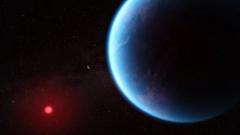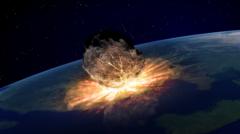Article Text:
Scientists have uncovered encouraging yet tentative evidence suggesting that K2-18b, a remote planet orbiting a distant star, may harbor life. A team from Cambridge University has detected molecules in the planet's atmosphere that, on Earth, are produced solely by simple organisms. This marks the second promising observation of life-related chemicals on K2-18b, facilitated by NASA's James Webb Space Telescope (JWST). However, both the research team and independent astronomers emphasize the need for more data to substantiate these findings.
Lead researcher Prof Nikku Madhusudhan, based at Cambridge University's Institute of Astronomy, expressed optimism about securing definitive evidence in the near future, stating, "This is the strongest evidence yet there is possibly life out there. I can realistically say that we can confirm this signal within one to two years."
K2-18b is approximately 2.5 times larger than Earth and located about 700 trillion miles away. The JWST's advanced capabilities enable it to analyze the chemical composition of the planet's atmosphere via light filtered through from its orbiting star. The Cambridge researchers detected indications of at least one of two molecules associated with life: dimethyl sulphide (DMS) and dimethyl disulphide (DMDS), which are produced by marine phytoplankton and bacteria on Earth.
Prof Madhusudhan noted his astonishment at the substantial quantity of gas detected, which was thousands of times greater than Earth’s levels. "If the association with life is real, then this planet will be teeming with life," he asserted. He further suggested that confirmation of life on K2-18b could imply that life is prevalent throughout the galaxy.
Despite these exciting prospects, there remains a significant scientific hurdle to clear. The detection is currently not robust enough for a definitive claim; the researchers are only 99.7% sure of their results, short of the 99.99999% certainty required for a five sigma result—the benchmark for confirming scientific discoveries.
Even achieving a five sigma result does not guarantee the existence of extraterrestrial life, according to Prof Catherine Heymans of Edinburgh University, an independent authority on the matter. She pointed out that the origin of the detected gases persists as a critical question, noting that their terrestrial sources arise from oceanic microorganisms, though other geological processes could potentially yield similar compounds.
The Cambridge team is investigating whether DMS and DMDS could be produced in non-biological ways in laboratory settings. Some alternative explanations for the data indicate that K2-18b could have a vast liquid ocean—suggested by a lack of ammonia in its atmosphere—or, conversely, be a molten rock ocean, which would hinder the possibility of life.
Different interpretations of K2-18b’s composition continue to fuel vigorous scientific debate. Dr. Nicolas Wogan from NASA's Ames Research Center has even proposed that K2-18b may lack a surface and be a mini gas giant, although these theories have been met with skepticism from other researchers.
Acknowledging the difficult journey ahead, Prof Madhusudhan remains hopeful. He stated, "Decades from now, we may look back at this point in time and recognize it was when the living universe came within reach. This could be the tipping point, where suddenly the fundamental question of whether we're alone in the universe is one we're capable of answering."
The findings have been published in The Astrophysical Journal Letters, highlighting a critical step forward in the quest to understand extraterrestrial life.
Scientists have uncovered encouraging yet tentative evidence suggesting that K2-18b, a remote planet orbiting a distant star, may harbor life. A team from Cambridge University has detected molecules in the planet's atmosphere that, on Earth, are produced solely by simple organisms. This marks the second promising observation of life-related chemicals on K2-18b, facilitated by NASA's James Webb Space Telescope (JWST). However, both the research team and independent astronomers emphasize the need for more data to substantiate these findings.
Lead researcher Prof Nikku Madhusudhan, based at Cambridge University's Institute of Astronomy, expressed optimism about securing definitive evidence in the near future, stating, "This is the strongest evidence yet there is possibly life out there. I can realistically say that we can confirm this signal within one to two years."
K2-18b is approximately 2.5 times larger than Earth and located about 700 trillion miles away. The JWST's advanced capabilities enable it to analyze the chemical composition of the planet's atmosphere via light filtered through from its orbiting star. The Cambridge researchers detected indications of at least one of two molecules associated with life: dimethyl sulphide (DMS) and dimethyl disulphide (DMDS), which are produced by marine phytoplankton and bacteria on Earth.
Prof Madhusudhan noted his astonishment at the substantial quantity of gas detected, which was thousands of times greater than Earth’s levels. "If the association with life is real, then this planet will be teeming with life," he asserted. He further suggested that confirmation of life on K2-18b could imply that life is prevalent throughout the galaxy.
Despite these exciting prospects, there remains a significant scientific hurdle to clear. The detection is currently not robust enough for a definitive claim; the researchers are only 99.7% sure of their results, short of the 99.99999% certainty required for a five sigma result—the benchmark for confirming scientific discoveries.
Even achieving a five sigma result does not guarantee the existence of extraterrestrial life, according to Prof Catherine Heymans of Edinburgh University, an independent authority on the matter. She pointed out that the origin of the detected gases persists as a critical question, noting that their terrestrial sources arise from oceanic microorganisms, though other geological processes could potentially yield similar compounds.
The Cambridge team is investigating whether DMS and DMDS could be produced in non-biological ways in laboratory settings. Some alternative explanations for the data indicate that K2-18b could have a vast liquid ocean—suggested by a lack of ammonia in its atmosphere—or, conversely, be a molten rock ocean, which would hinder the possibility of life.
Different interpretations of K2-18b’s composition continue to fuel vigorous scientific debate. Dr. Nicolas Wogan from NASA's Ames Research Center has even proposed that K2-18b may lack a surface and be a mini gas giant, although these theories have been met with skepticism from other researchers.
Acknowledging the difficult journey ahead, Prof Madhusudhan remains hopeful. He stated, "Decades from now, we may look back at this point in time and recognize it was when the living universe came within reach. This could be the tipping point, where suddenly the fundamental question of whether we're alone in the universe is one we're capable of answering."
The findings have been published in The Astrophysical Journal Letters, highlighting a critical step forward in the quest to understand extraterrestrial life.









